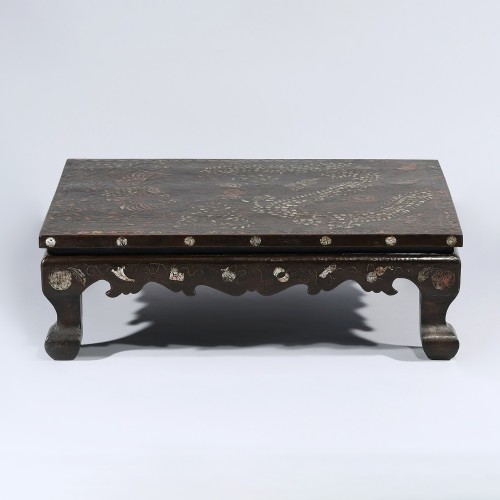본문
궁중 대모 어피 나전 용봉문 사각상은 조선시대 궁중에서 사용된 고급 가구로, 대모와 어피, 나전으로 용과 봉황 등 길상 문양을 정교하게 장식한 사각형 상입니다. 여기서 ‘대모’는 바다거북 껍질을, '어피'는 어류 가죽을 가공한 장식재를 의미하고 ‘나전’은 전복이나 조개의 얇은 껍질을 깎은 자개를 붙이는 전통 장식 기법입니다. 보통 이러한 재료와 기법은 왕실이나 상류층 가구에 주로 쓰였습니다.
이 유물은 사각형 상판을 가지고 있어 전체적으로 반듯한 형태이고 다리는 곡선미가 강조된 호족반(虎足盤)으로 안정감과 장중함이 느껴집니다. 상판에는 나전으로 용과 봉황 문양이 화려하게 장식되어 있습니다. 용은 왕권과 권위, 봉황은 왕비와 고귀함을 상징하는 존재로, 이 두 문양이 함께 등장한 것은 왕실의 위엄과 번영을 의미합니다. 또한 주변에는 박, 식물, 덩굴 형태의 당초문(唐草文) 등 길상적 요소들이 함께 배치되어 부귀와 장수를 기원하는 상징성을 더합니다.
조선시대의 나전 기술은 정밀한 선묘와 절묘한 색감 배치로 세계적으로도 높은 예술성을 인정받았으며, 특히 궁중에서 제작된 나전 가구는 극도의 장식성과 정교함을 보여줍니다. 이 사각상 또한 그러한 전통의 연장선에 놓이며, 예술성과 실용성을 동시에 갖춘 예시로 평가됩니다.
━━━━━
此宫中玳瑁鱼皮螺钿龙凤纹方几是朝鲜时代宫廷使用的高级家具之一。方几以玳瑁、鱼皮、螺钿等珍贵材料精心装饰,图案采用象征吉祥的龙与凤凰纹样,工艺极为精巧。其中玳瑁是指海龟甲壳,鱼皮则是一种用鱼类皮革经过加工的高级装饰材质,螺钿工艺则是将鲍鱼或贝类的薄壳削制成薄片后贴饰于物体表面的传统装饰技法。这些材料与工艺通常用于王室或上层阶级的家具之中,彰显其尊贵身份。
此件方几结构端正,腿部呈虎足盘曲线,造型稳重而富于动感。几面以螺钿精饰龙与凤凰图案,龙象征王权与威严,凤凰象征王妃与高贵,二者共现,寓意王室的威仪与昌盛。图案周围则辅以瓜果、植物、蔓藤等唐草纹图案,寄托了对富贵与长寿的美好愿景。
朝鲜时代的螺钿工艺以线条精细、色彩协调而闻名于世,尤其宫廷所制,更体现出极致的装饰性与工艺水准。本器物亦延续了这一传统,兼具艺术性与实用性,堪称代表性之作。
━━━━━
This rectangular court table is a luxurious piece of furniture used in the royal court during the Joseon Dynasty. It is elaborately adorned with auspicious motifs such as dragons and phoenixes using tortoiseshell, processed fish skin, and mother-of-pearl inlay. Here, "tortoiseshell" refers to the processed shell of sea turtles, "fish skin" denotes finely treated fish leather used as a decorative material, and "mother-of-pearl inlay" is a traditional Korean decorative technique that involves attaching thinly sliced layers of abalone or clam shells. These materials and techniques were typically reserved for royal or aristocratic furnishings.
This artifact features a square top, giving it a well-balanced appearance, and rests on tiger-leg-shaped curved legs that convey both stability and elegance. The tabletop is richly embellished with mother-of-pearl designs of dragons and phoenixes. In Korean court symbolism, the dragon represents kingship and authority, while the phoenix symbolizes the queen and nobility. The presence of both motifs together signifies royal dignity and prosperity. Surrounding these main designs are additional auspicious elements such as gourds, foliage, and arabesque patterns, further enhancing the table’s symbolic wish for wealth, longevity, and good fortune.
Mother-of-pearl inlay art from the Joseon period is globally recognized for its precise line work and exquisite color composition. Especially in royal pieces, najeon craftsmanship reached exceptional levels of detail and decorative richness. This rectangular table is a continuation of that tradition, serving as an exemplary work that balances artistic excellence with functional design.

